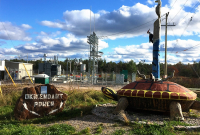Support strong Canadian climate journalism for 2025
The federal government is investing over a billion dollars to help Saskatchewan and New Brunswick clean up their electricity production. A key priority for the funding will be Indigenous-led initiatives that help provinces transition away from fossil fuels.
“The investments that we saw this week are going to help Saskatchewan and New Brunswick on the path to net-zero electricity because they’re paying for the things that we know work when it comes to wind, solar, energy storage and grid upgrades, and Indigenous involvement in all of those things,” said Stephen Thomas, clean energy manager at the David Suzuki Foundation.
The government of Canada announced last week that it will provide Saskatchewan with more than $250 million to help SaskPower and proponents shift to lower-carbon, affordable energy production. They also announced over a billion dollars in federal support to New Brunswick.
At present, approximately 28 per cent of New Brunswick’s electricity generation and 80 per cent of Saskatchewan’s come from burning fossil fuels like coal, natural gas and petroleum, contributing to carbon emissions that cause global warming.
Both provinces plan to use a substantial amount of the money to ensure Indigenous communities benefit from electricity projects on their land. That way, they’ll be able to reinvest profits within their community.
Building clean electricity infrastructure is important to supporting the national economy within Indigenous communities and throughout Canada, Thomas said.
“When we move to clean electricity, we’re investing billions of dollars here in Canada for clean energy jobs, both for the building of new clean electricity generation but also for upgrading and maintaining a larger electricity grid as we need electricity for more things in the future,” he said.
Currently, when Canadians use fossil fuels, that money is primarily spent on imported fuels or paying the profits of foreign-owned companies in Canada. As we transition to clean-energy infrastructure, Canada has the opportunity to ensure money spent on this shift is returned to our economy, Thomas said.
Going forward, “one of the most pressing issues for Canada is being able to train enough workers to support the transition to clean energy,” he added. According to a 2023 report by Clean Energy Canada, by 2050, there will be 700,000 more jobs in the energy sector, including roles in maintenance and construction.
The new federal funding will go primarily to hydropower, wind and solar projects. However, some of the money awarded to New Brunswick will be for biomass projects which involve burning leftover plant materials like wood chips.
Critics say shifting from burning fossil fuels to wood isn’t enough to address the climate crisis. They argue that the amount of time it takes for a forest to regrow and absorb the carbon emitted from burning biomass won’t be able to keep up with its emissions, making it unsustainable.
“We do see a little bit of money for biomass projects in this announcement, and we think that that’s a little bit disappointing – there’s certainly not as many benefits from biomass, and it’s certainly a much more expensive form of clean electricity.”
Nevertheless, these projects will help Saskatchewan and New Brunswick lower Canada’s carbon emissions. Thomas explains that some provinces have historically relied on fossil fuels more than others, and funding to help build clean-energy infrastructure helps them transition from them in an affordable way.
As such, Thomas is waiting for the federal government to release the final Clean Energy regulations by the end of the year, which he says will help show communities across Canada the benefits of clean energy.
With files from Natasha Bulowski






Comments